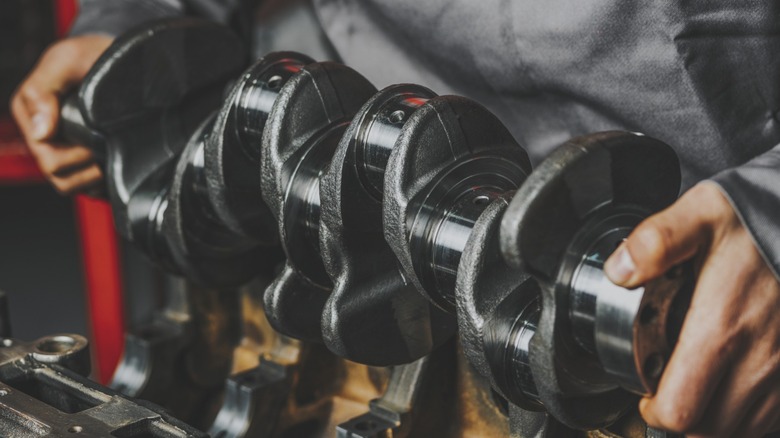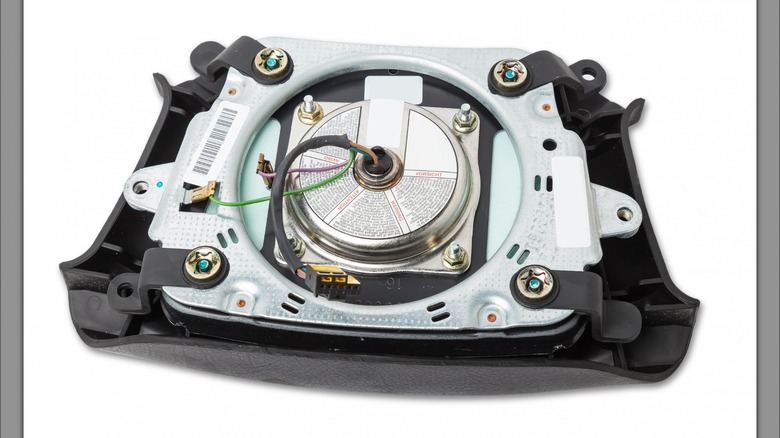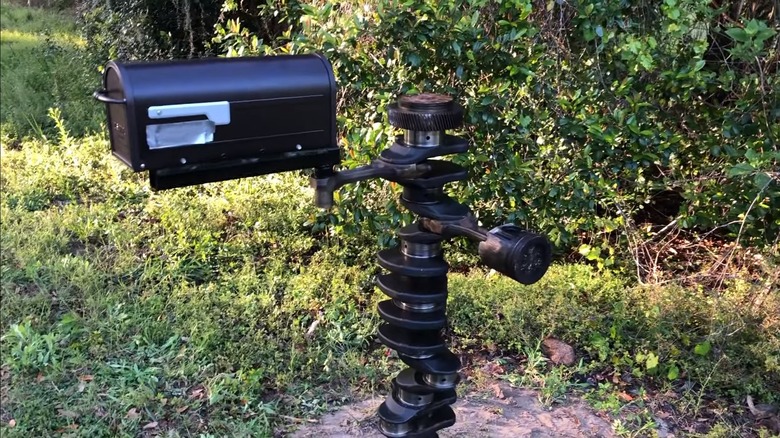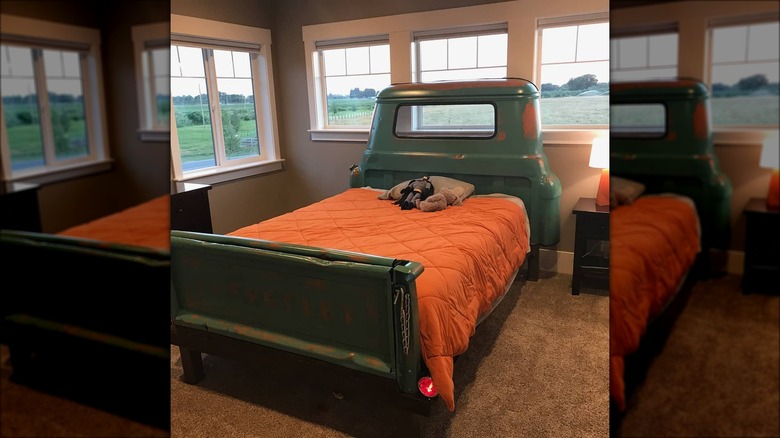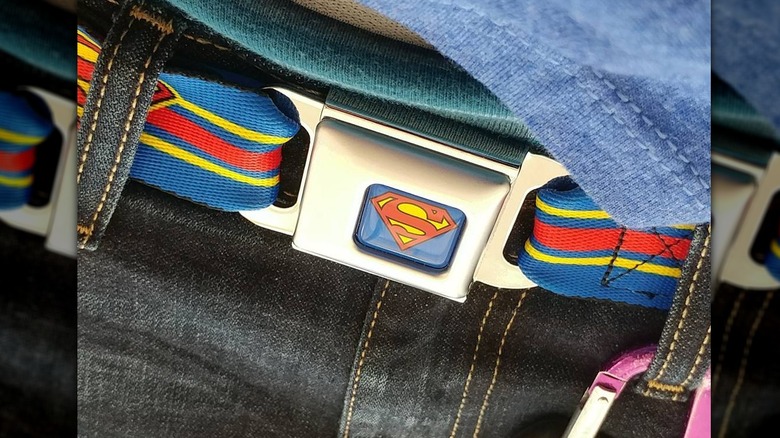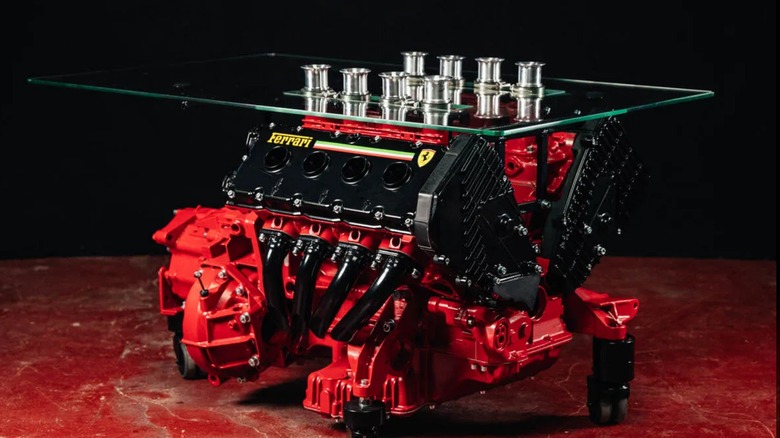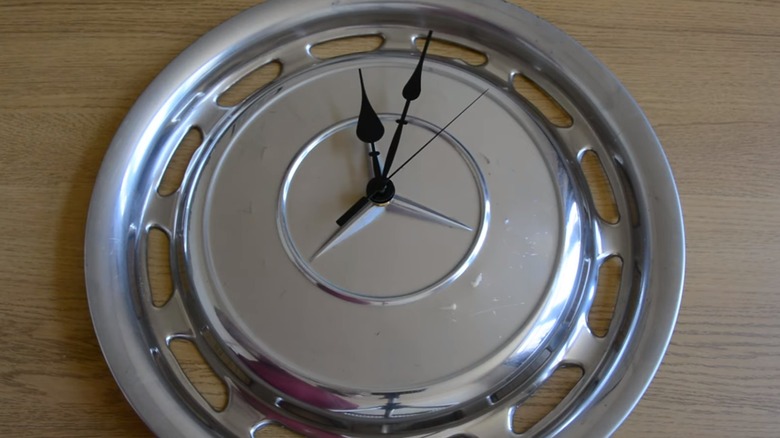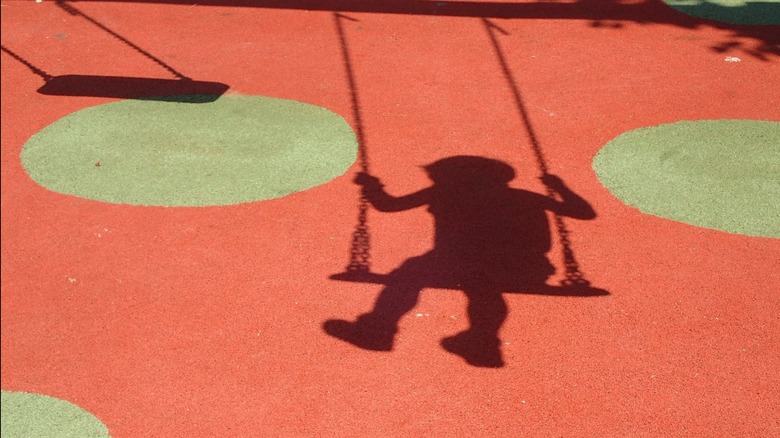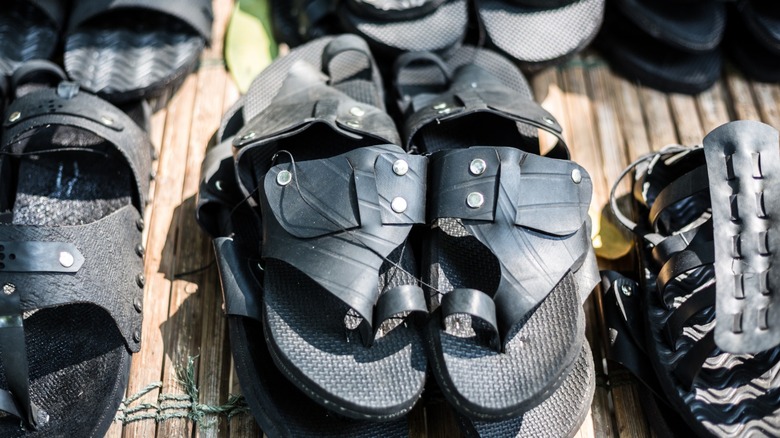8 Unexpected Uses For Old Car Parts
Car parts getting used up, worn out, outdated, and generally useless is a fact of life of car ownership. No matter how nice and how new your vehicle may be, it will require new parts at some point. Components such as brakes and filters require regular maintenance, while suspension parts all get worn down with enough miles put on them. This has led to an auto parts industry in the U.S. with a value of more than $80 billion that employs nearly half a million people. This means there are tons of auto parts on shelves waiting for the next repair, covering everything from replacement filters to a broken vanity mirror. However, when you have to replace something, what happens to the old part?
The good news about old cars and car parts is that there is an extremely high rate of recycling taking care of them. Most of that comes from whole cars being recycled — up to 75% — at the end of their lives, but scrap metal recycling helps take care of replacement parts as well. However, many parts, such as alternators and brake calipers, are reconditioned and sold as "like-new" parts. Reusing them for their intended purpose is great, but sometimes, people find novel ways to repurpose parts for unintended uses, often with surprising results.
Considering just how talented and ingenious our fellow humans can be, these old car parts have been reused in ways you probably did not expect.
Pranks
If you have not been exposed to this idea, it should surely come as a big surprise. This is a clever, if not potentially dangerous, reuse for a car's airbags. Something you also may not know is what makes an airbag work, which is what drives the prank.
In a collision, your car has sensors in the bumpers set to activate should the impact rise above a certain amount of force. When triggered, sensors send a signal to the computer. Different sensors trigger different airbags, and this can happen in a fraction of a second. When the airbag receives a signal, an igniter sets off a reaction between sodium azide and potassium nitrate, causing the bag to rapidly fill with nitrogen gas. The inflated bag absorbs impact, thus protecting passengers.
The prank here involves taking a spare airbag and placing it strategically within, for example, a sofa cushion. With a remote trigger and a 12-volt power source, the airbag can be activated, causing it to rapidly inflate and send whoever is sitting on said cushion flying into the air. You may have seen this immortalized in a scene in the Seth Rogan movie, "Neighbors." However, this is dangerous and could potentially cause harm, so do not try it.
To clarify the danger, this prank has been tested scientifically and proven it could work, but not without great risk of injury. Furthermore, performing this prank, called popcorning, could get you sued or charged with a crime. However, it is still perfectly safe and legal to see how it plays out for real in this clip from a decade ago.
Mailbox post
Engines are heaps of metal parts assembled in such a way as to convert liquid fuel into energy. These are complex machines that rely on advanced engineering to create the parts needed and in what way they are assembled to create the desired outcome, whether that is high fuel efficiency or maximum power output. There are thousands of different designs of engines of all different sizes, but they all rely on some of the same components, with a few notable exceptions. These parts include the pistons, rods, crankshaft, and camshaft, just to name a few. Once the engine is worn out, these parts generally have little use but to be melted down for scrap.
Sometimes the crankshafts or camshafts can live a new life with a more sedentary purpose. Since the camshaft and crankshaft are both made from thick and solid steel, they are extremely strong. This has left some inventive home builders to use them to support a mailbox. While this is effective, the aesthetic dynamic may not be for everyone. Furthermore, using engine parts to support your mailbox may very well go against your homeowner's association guidelines. If not, then you do you. It's your mailbox after all. Also, this is a more common practice than you probably realize. A Google image search for a crankshaft mailbox post reveals an endless stream of images.
Beds
It can be hard to determine what to do with a vintage or antique pickup truck once it is beyond restoration to put it back on the road. An old truck could be easily recycled just like any other vehicle, but for some, old trucks are still a thing of beauty to be cherished and not just discarded. The good news for old truck lovers is that the beds from these old trucks can continue to bring joy as beds for sleeping.
Someone with some very inventive and clever thinking has taken portions of a classic Chevrolet pickup and converted it into the ultimate in-home decor for the truck lover. Using the back side of the cab and the tailgate section of the rear of the truck, they have made it a bed, complete with headboard and footboard straight from Detroit. The resulting furniture pieces make for an impressive design choice, and would work perfectly in someone's bedroom, albeit not everyone's. The Etsy shop for Tailgate Customs is still up but no longer has any listings, so no new orders appear to be available at this time.
Nothing is stopping you from getting an old pickup and creating your own bed. However, as an alternative, Etsy seller brianbauer1 sells fiberglass replica beds of the same style that are hard to tell apart from the real thing.
Belts
Seatbelts are life-saving devices that are crucial for travel in any automobile. First offered in 1949, seatbelts remained optional until Wisconsin passed the first law requiring them in new cars in 1961. Volvo created the first three-point harness, though federal law did not require them in new cars until 1968. Today, seatbelts are second nature to most, and it would be tough to imagine getting in a car without first buckling up. Furthermore, many who were around in the '70s through the '90s remember the standard metal buckle found in cars across all divisions of General Motors. It seems these particular buckles and more have found second lives today.
Searching through the store on Etsy, one can find a large selection of seat belts and buckles repurposed for a range of fashion accessories. The most common use is for a belt for your pants. The metal buckles commonly used until the '90s make for a perfect quick-release belt that is known to hold securely in most conditions. Products from Etsy are hand-crafted and you can expect to find many repurposed items on the site. Other related products include handbags made from recycled seatbelt webbing and others using the buckle as a clasp. Hot Topic also sells belts like this, but they are likely reproduction units mass-produced in China. There is also a company called SkyBelts that repurposes old airplane seat belts into fashion accessories using genuine aviation buckles and webbing.
Tables
Old engine blocks rarely find a new life once they have been worn beyond the point of rebuilding. It is generally in the furnace to be melted down and turned into something new. Perhaps, however, you have an old engine that is just too precious and its sentimental value precludes any ideas of the furnace. Apparently, you can turn that old hunk of iron into a table.
This practice is most notable for being the basis of the table used on the Top Gear set for many seasons, which is a glass top sitting on a V12 engine block. While that seems an ideal piece of decor for a motoring show, the trend is much more popular than you may think. Searches online for engine tables turn up many websites devoted to converting old engine blocks into tables, with many more listed on eBay and Etsy. As recently as August 2023, Bring a Trailer auctioned off a table made from a Ferrari F10-5 V8. It had the engine and transaxle as the base, complete with cylinder heads and valve covers, with the air horns for the intake sitting on top of the glass as if the intake was going through it. That auction ended at $18,500, meaning some Ferrari lover must have really wanted that table.
Clocks
Hubcaps have been covering the wheels of cars since the 1930s. Since then, manufacturers have created elaborate designs for the wheel covers sold with cars from across the spectrum from a base model Chevrolet to the largest and grandest Cadillac. These designs helped to define the brand by what was on the wheels. Yet, because of the introduction of cheap and durable plastic, many wheel covers have become ordinary and less distinguished. Today, most cars above the base level of affordable cars come with alloy wheels, created with designs of distinction that set off the overall appearance. With older cars leaving the road, the abundance of older hubcaps has led to many upcycling them into something more timeless, clocks.
Creating a clock from a hubcap seems kind of like an obvious thing to do. The hubcap is large and round, which makes a perfect background for a clock. With a drill and a cheap battery-powered clock mechanism, you can have a wall clock in minutes. These clocks certainly have their place in specific locations like man caves, themed restaurants, garages, and auto-related businesses. However, they do offer a special charm that lovers of classic cars in particular will love. The Drive offers instructions on how you can make your own.
Playgrounds
Annually, up to 1.5 billion tires are discarded globally. It is a big problem that many people have been working on for years to find solutions for. The biggest problem is that so many of these tires are sent into landfills, burned, or stockpiled with few options for handling them with special regard to the environment. With billions more expected next year and the year after, we need to find creative solutions for properly disposing of them.
While it will never eradicate the used tire problem, some have found helpful reuses for them. Waste tire material has found new life in playgrounds in a couple of ways. Tire swings have long been a fixture on playgrounds, but that is only the use of a single tire. Crumb rubber mulch is another way that has found its way into modern outdoor spaces. Discarded tires are processed to remove the metal and the remaining rubber material is shredded into semi-coarse pieces to form a mulch. However, health hazards associated with used tire material have arisen and much study is being conducted on its safety.
An alternate product uses recycled rubber to make a solid yet flexible playground surface. This is more like a rubber carpet for the outdoors that is also made from recycled rubber but has less potential for toxic exposure. It has the benefit of being pliable and durable while also being porous and promoting proper drainage.
Sandals
In Africa, a practice dating back to the 1930s has seen indigenous people make footwear from discarded tires. During the Italian occupation of East Africa in 1935, Ethiopian rebels made sandals from used tires while fighting to drive the Italians out of their homeland. In a land that has been historically conquered and occupied and where natural resources are less abundant than in other parts of the world, innovation in fulfilling basic needs has always bred ingenuity.
The practice of making tire sandals continues today, providing a way to eliminate tire waste while offering a needed and valued commodity to the people of Africa. These sandals are known in East Africa as "Ten-Thousand Milers." They use old tires combined with camel leather and traditional beadwork to create sandals that are also made using traditional techniques. For the impoverished people of these lands, new sandals can cost the equivalent of just $2.40 per pair while employing the people making them. In addition to providing work and helping to clear up old tires, the material used is extremely durable and tough, making the sandals perfect for walking over the rough and often jagged terrain of the savannah and desert areas of the continent.
